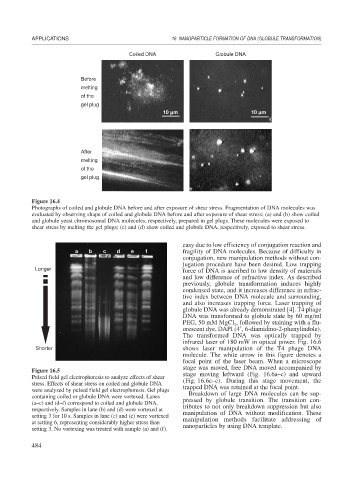Page 512 - Book Hosokawa Nanoparticle Technology Handbook
P. 512
APPLICATIONS 16 NANOPARTICLE FORMATION OF DNA (GLOBULE TRANSFORMATION)
Coiled DNA Globule DNA
Before
melting
of the
gel plug
10 µm 10 µm
After
melting
of the
gel plug
Figure 16.4
Photographs of coiled and globule DNA before and after exposure of shear stress. Fragmentation of DNA molecules was
evaluated by observing shape of coiled and globule DNA before and after exposure of shear stress; (a) and (b) show coiled
and globule yeast chromosomal DNA molecules, respectively, prepared in gel plugs. These molecules were exposed to
shear stress by melting the gel plugs; (c) and (d) show coiled and globule DNA, respectively, exposed to shear stress.
easy due to low efficiency of conjugation reaction and
a b c d e f fragility of DNA molecules. Because of difficulty in
conjugation, new manipulation methods without con-
jugation procedure have been desired. Low trapping
Longer force of DNA is ascribed to low density of materials
and low difference of refractive index. As described
previously, globule transformation induces highly
condensed state, and it increases difference in refrac-
tive index between DNA molecule and surrounding,
and also increases trapping force. Laser trapping of
globule DNA was already demonstrated [4]. T4 phage
DNA was transformed to globule state by 60 mg/ml
PEG, 50 mM MgCl , followed by staining with a flu-
2
orescent dye, DAPI (4 , 6-diamidino-2-phenylindole).
The transformed DNA was optically trapped by
infrared laser of 180 mW in optical power. Fig. 16.6
Shorter shows laser manipulation of the T4 phage DNA
molecule. The white arrow in this figure denotes a
focal point of the laser beam. When a microscope
stage was moved, free DNA moved accompanied by
Figure 16.5
Pulsed field gel electrophoresis to analyze effects of shear stage moving leftward (Fig. 16.6a–c) and upward
stress. Effects of shear stress on coiled and globule DNA (Fig. 16.6c–e). During this stage movement, the
were analyzed by pulsed field gel electrophoresis. Gel plugs trapped DNA was retained at the focal point.
containing coiled or globule DNA were vortexed. Lanes Breakdown of large DNA molecules can be sup-
(a–c) and (d–f) correspond to coiled and globule DNA, pressed by globule transition. The transition con-
respectively. Samples in lane (b) and (d) were vortexed at tributes to not only breakdown suppression but also
setting 3 for 10 s. Samples in lane (c) and (e) were vortexed manipulation of DNA without modification. These
at setting 6, representing considerably higher stress than manipulation methods facilitate addressing of
setting 3. No vortexing was treated with sample (a) and (f). nanoparticles by using DNA template.
484

